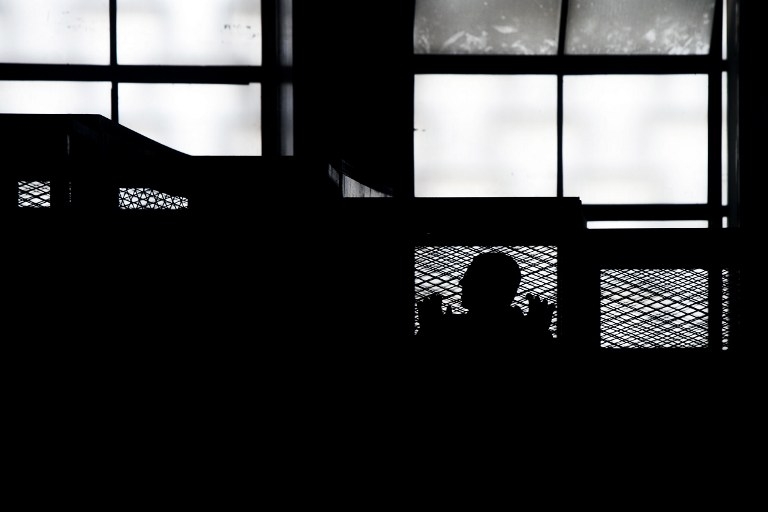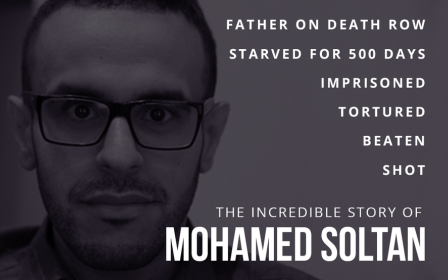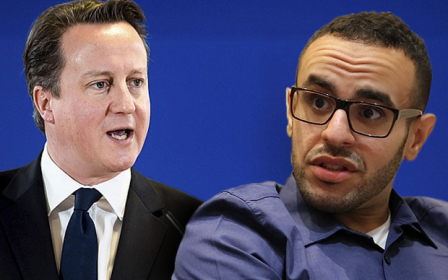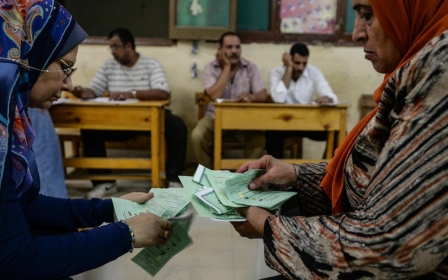The disappearance of Amr Ali

CAIRO - Last month, the leader of one of Egypt's best known opposition movements disappeared.
Amr Ali, 32, was taken from his home in Shebeen el-Kom in the Menoufia governorate north of Cairo at around 5pm on 22 September. Amr is the head of the April 6 Youth Movement, a group that was the central mobilising force behind Egypt's 2011 uprisings, and that is often credited with having played a critical role in forcing the country’s former president Hosni Mubarak out of office.
For nearly three days, no one knew where Amr Ali was. Then, on 25 September, rumours began to circulate in the activist community that Amr had appeared in Egypt's most famous prison, al-Tora.
A warrant for Ali’s arrest had been issue in June after an April 6 member was arrested in Cairo for distributing flyers in support of a general strike. But members of the April 6 movement told MEE that Amr Ali had not been questioned nor formally arrested. His family and friends told them that Ali had simply been taken by the security forces.
Amr was elected to head April 6 after its former head, the well-known political activist Ahmed Maher, was sentenced to three years imprisonment - along with fellow opposition leaders Ahmed Douma and Mohammed Adel - after the 2013 Egyptian military coup.
Amr knew the job was a risky one but was no stranger to the dangers of political activism in Egypt. During the Mubarak era, he was arrested four times at anti-government protests and was arrested by the military police during the 2011 uprisings.
It wasn't until 28 September, six days after his disappearance, that Amr's brother - who had heard rumours that his brother was in Tora prison - was able to enter the jail and confirm his brother's location.
In the prison, he found that Amr been interrogated without the presence of a lawyer and that a decision had been taken to remand him in jail for a further 15 days, an order that has since been renewed twice.
He has not been charged and his fate remains unclear, but for now Amr Ali will reside in Egypt's prison system, along with the former head of April 6, Ahmed Maher.
Tracking down the missing
Hundreds of civilians have been disappeared by Egypt's security forces this year, and most of them aren't located within a few days. Since March, there has been a startling growth in the use of disappearance as a security forces tactic to target Egypt's dissidents.
The Egyptian Coordination for Rights and Freedoms (ECRF) was founded in Cairo in August 2014 to draw attention to what its founders foresaw would be a major concern in the new Egypt. Inspired by the work of rights groups in Chile that had organised against forced disappearances under General Augusto Pinochet, they soon formed a group of committed volunteers.
The group is running a campaign called “stop enforced disappearance” and it maintains a list of people whom it believes to have been disappeared by state security forces. For all those that it can identify, the group tracks down a photograph of the missing person to use when publicising the case online. Most are young men in the twenties or early thirties; some are younger.
In a recent case, on 1 September, a young man named Anas Abdel Moneim was kidnapped from a restaurant and bundled into a white car, according to his family. ECRF says it was men from Amn al-Watany, Egypt's internal intelligence agency, who took him. The family have been trying to make formal inquiries as to where their son is but still haven't been told where he's being held.
Anas's family's story is not an aberration, but commonplace. In the month of May alone, there were enough enforced disappearances to average at a rate of more than 12 per day, according to ECRF.
Since the beginning of 2015, the ECFR and Freedom for the Brave, another Egyptian NGO, have documented more than 1,700 cases of enforced disappearance. That figure only represents the reported cases and it excludes North Sinai province. Of those disappeared in the first half of the year, 128 were students, and 35 were under the age of 18. At least 280 of them are still missing.
On 1 June, Esraa el-Taweel, 23, and her two friends, Omar Ali and Sohaib Saad Al-Haddad, were disappeared in the Cairo suburb of Maadi. Esraa was eventually located in the Qanater women's prison, but the precise whereabouts of Omar and Sohaib have not been firmly established.
Five of the 1,023 cases the ECRF documented in the first six months of 2015 had actually been disappeared in 2014, but were yet to appear in any records whatsoever. Others have reappeared more than a year and a half later and refused to speak about what happened to them.
Months of torture
One case that drew particular attention on social media, although not in the established Egyptian press, was that of Islam Khalil. Islam was taken in Gharbiya, in the north of Egypt, and disappeared for more than 120 days before emerging hundreds of miles away in Alexandria's Borg al-Arab prison on 23 September.
An arrest date had been forged that made it look as though he had been arrested earlier that day, and Islam was charged under the Terrorism Act. He said he had spent the preceding four months being tortured in the headquarters of Amn al-Watany, Egypt's internal intelligence agency, in Lazoughly square, Cairo.
In another high-profile case, Mustafa Mahmoud Ahmed al-Masouny was disappeared on 26 June this year after he went out to the shops. Many in the human rights movement believe he is being held in Lazoughly, although more than three months later, no one knows for certain where he is.
According to Ezzat Ghonaim, director of the ECRF, Lazoughly, notorious among Egyptian prisons and the headquarters of Amn al-Dowla during Mubarak's era, is the heart of enforced disappearance in Egypt. “Lazoughly is the centre of Amn al-Watany's activity, a huge number of disappeared people are taken there,” he told MEE in the organisation's office in Cairo.
Ghonaim described the case of Mohamed Abdel Hamid Ahmed, who was recently found in Lazoughly having been disappeared two years earlier. Another young man, who cannot be named for safety reasons, was disappeared by security forces in Cairo's Nasr City district and taken to Lazoughly where he met Mohamed alone in a neighbouring cell. When the man was assigned the cell next to Mohamed, he had spoken to him and found that Mohamed had been so isolated that he was not even aware that the year was 2015.
Found dead in the desert
Some cases of disappearance end not in mystery but death. One was that of Islam Atiaa, an engineering student at Ain Shams University, who was taken from the university campus. Just 48 hours later, Islam was found dead in the desert near the Togammaa el-Khames district on the outskirts of Cairo.
At first, the authorities claimed not to know who the body they found belonged to, but then the story changed. The official line became that Islam was a terrorist who had been killed in a firefight with the police. There was a problem with this account. CCTV footage from the university showed that Islam being taken by officials. The case is still being investigated by Egypt's public prosecutor.
According to Ghonaim, besides political activists and students, the group at highest risk of enforced disappearance are university professors, who make up nearly 10 percent of the cases of disappearance the ECRF has documented.
Aside from Lazoughly, a handful of other security forces buildings keep cropping up in cases of enforced disappearance: the Amn al-Watany headquarters building in Sheikh Zayed, the S6 military base in Maadi, and the notorious fourth floor of the Alexandria security directorate. However, the ECRF believes that 90 percent of security directorates and police stations have been used to hold disappeared people at one time or another.
“There are many open cases against the Ministry of Interior because of disappearances,” Ghonaim, who is a qualified lawyer, told MEE. “But these cases are mostly to try to force information out. There's no hope of any official being prosecuted because they are above the law. All fascist regimes have always done this: it's to make the opposition too afraid to oppose.”
'There is no law'
When someone is disappeared and taken to the Amn al-Watany they are usually tortured, according to Khalid Abdel Hamid, one of the founders of the Egyptian rights organisation Freedom for the Brave.
“This can be to get them to give information about their friends, or a group they belong to,” Abdel Hamid told MEE. “Torture is also used to get people to sign a confession to a crime.”
“It's a message from the regime to people and activists that there is no law, that they should be afraid, that they can take you, torture you, do anything, and there's nothing you can do about it.”
Egypt's interior ministry denies that there have been any cases of involuntary or enforced disappearance in Egypt. Salah Fouad, the interior minister's aide for human rights, said precisely this in a statement on 14 October. "While freedom is guaranteed to everyone, the state has the right in certain cases and under specific conditions to restrict the freedom of those who violate the law,” he said.
Freedom of the Brave responded directly to Fouad's comments, which it described as a complete denial of the facts. “No one expected that General Salah Fouad would offer anything different than the statement he gave,” the group said in a statement. “It is not expected that the interior ministry would admit these crimes, just as it has denied the existence of torture, the use of snipers, and the existence of political prisoners.”
Disappearing the leader of what is perhaps the country's best known opposition movement after the Muslim Brotherhood is a bold play by the security forces. Amr Ali's high profile may have helped in his family's efforts to quickly locate him, but the message is not one that the opposition can ignore.
For the hundreds of others who have vanished without an organised movement behind them, abuses and obscurity are all that is ensured.
Middle East Eye propose une couverture et une analyse indépendantes et incomparables du Moyen-Orient, de l’Afrique du Nord et d’autres régions du monde. Pour en savoir plus sur la reprise de ce contenu et les frais qui s’appliquent, veuillez remplir ce formulaire [en anglais]. Pour en savoir plus sur MEE, cliquez ici [en anglais].





